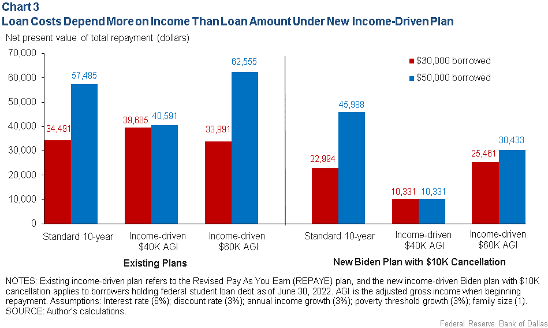Student loan balances have spiked in the last few years. The average balance increased from $29,000 in fourth quarter 2016 to more than $36,000 in fourth quarter 2021. To reduce this burden, President Biden announced the Student Loan Forgiveness Plan (the Plan) in August 2022. It forgives $10,000 of student debt for borrowers earning less than $125,000 per year, and up to $20,000 for former Pell Grant recipients.
There is another component of the Plan that may have an even greater impact on student loans over the long term. Instead of using the standard repayment plan, there is an improved set of Income-Driven Repayment (IDR) plans that borrowers can use to pay back their loans. IDR plans have proven popular with borrowers, with the percent using them rising from 26% in 2016 to 34% in 2021.
IDR’s make monthly loan payments more affordable by adjusting for borrower income and family size. Biden’s Plan requires borrowers to pay just 5% of discretionary income rather than the previous 10%.
A Comparison of Existing and New IDR Plans
Because of the adjustment of the poverty threshold necessitated by inflation, it’s helpful to look at student loan costs in today’s dollars—the net present value. The left side of Chart A, below, illustrates the net present value of repayments under existing plans. The right side shows the net present value of repayments under the Biden plan.
Chart A: Comparison of Existing and New Repayment Plans

Under the new REPAYE plan, loan costs are more dependent on income than on the amount borrowed at origination. REPAYE is the preferred IDR plan for lower-income borrowers with large loan debt. It allows borrowers with discretionary income under 150% of the poverty line to forego payments.
Co-opting of Federal Student Aid Funding by Colleges
The Administration is being careful to avoid the usual fate of financial aid programs that are initiated by the Federal government to benefit students. In the past, there has been a direct link between new aid programs and proportional increases in tuition by colleges. These tuition increases have had the effect of colleges gobbling up Congressionally-appropriated funds rather than allowing the funds to benefit students.
President Biden announced plans to monitor colleges and hold them accountable, especially with respect to this aspect of tuition increases. To enable applicants to avoid colleges that create unmanageable levels of student debt, the U.S. Education Department (ED) will list them at studentaid.gov. “If you’re going to spend money to go to college, you should be walking out with higher earning potential, so you can take care of those loans,” ED Secretary Miguel Cardona observed. “And if that’s not happening at colleges, whether they’re private or public, we want to know, and we want to go after that.”
Legal Challenges Are Unlikely to Succeed
The viability of the one-time $10,000/$20,000 loan forgiveness scheme now awaits review by the Supreme Court. The outcome is uncertain. Many college financing experts say the Administration’s changes to IDR plans are more likely to resist court challenges. “The IDR changes are on a much stronger legal footing,” said Kevin Carey, VP at New America, a think tank. “The Obama administration has already done this, and no one challenged it in court.”
What Are IDR Plans?
IDR plans base the monthly loan payment on the borrower’s income, not the amount of debt owed. This can make payments more affordable, especially if a student’s total loan debt is greater than their annual income. Monthly payments on IDR plans are usually lower than on standard plans. They may even be zero for borrowers with low or no income.
The four IDR’s offered by the ED are:
- Income-Contingent Repayment (ICR)
- Income-Based Repayment (IBR)
- Pay-As-You-Earn Repayment (PAYE)
- Revised Pay-As-You-Earn Repayment (REPAYE)
Table A shows how IDR plans differ in certain features:
Table A: Features of IDR Plans for Undergraduates
IDR Plan % of Discretionary Income Definition of Discretionary Income Repayment Term
ICR 20% AGI – 100% PL 25 years
IBR 15% AGI – 150% PL 25 years
PAYE 10% AGI – 150% PL 20 years
REPAYE 10% AGI – 150% PL 20 years
[Source: Federal Reserve Bank of Dallas]
Notes: Discretionary income is the amount by which adjusted gross income (AGI) exceeds 100% of the poverty line (currently $13,590 for a 1-person household and rising to $46,630 for an 8-person household). ICR plans subtract 100% of the poverty line and IBR, PAYE, and REPAYE subtract 150%. The PAYE plan forgives graduate school debt in 20 years and the REPAYE plan in 25 years.
The Pro’s and Con’s of IDR Plans
While there are many benefits of IDR plans, there are also drawbacks, as noted below.
Pro’s:
• Assisting the Unemployed: IDR plans are helpful to borrowers who are unemployed and have exhausted their eligibility for an unemployment and/or an economic hardship deferment. Since payments are based on income, they can be $0 under such circumstances.
• Lower Monthly Payments: With IDR plans, loan payments are based on discretionary income. The plans offer low-income borrowers with the lowest monthly payments among all repayment plans.
• The Remaining Balance Is Forgiven: After 20 or 25 years of repayment, the remaining loan balance is forgiven. The repayment term depends on the type of IDR plan. It is 25 years for ICR and IBR, and for graduate school loans under REPAYE. The term is 20 years for PAYE and for borrowers who have undergraduate loans under REPAYE.
• Interest May Be Paid by the Government: The ED pays all or part of accrued but unpaid interest on some loans under certain IDR plans. During the first three years, the ED pays all accrued but unpaid interest on subsidized loans in IBR, PAYE, and REPAYE plans and half of the accrued but unpaid interest on unsubsidized loans on REPAYE plans. For the remainder of the term, the ED pays half of the interest for all REPAYE plans. All other interest remains the responsibility of the borrower.
• Credit Scores Are Not Impacted: IDR plans will not hurt the borrower’s credit scores if he or she makes the required monthly loan payments. Borrowers will be reported to credit bureaus as current even if the required monthly payment is zero.
Con’s
• Eligibility Is Limited: Federal Parent PLUS loans are not eligible for IDR plans, but may become eligible for an ICR plan if the Parent PLUS loans are included in a Federal Direct Consolidation Loan.
• The Balance Can Increase: It is possible for student loans to be negatively amortized under IDR plans. Negative amortization occurs when the loan payments that the borrower is making are less than the new interest that accrues in a month. This causes the loan balance to increase. It is irrelevant, however, if the borrower eventually qualifies for loan forgiveness.
• Taxes Are Owed On Forgiven Debt: The amount of IDR loan balances that is forgiven is treated as taxable income under current law. The IRS treats any debt cancellation as income to the borrower. In effect, the tax liability that results from loan forgiveness substitutes a small tax debt in exchange for the much greater amount of the remaining balance of the loan.
• The Rules Are Confusing: There are four IDR plans and it’s often difficult for borrowers to determine which plan is best for them. Many details differ among the plans and they generate a range of long-term ramifications.
• Payments Can Increase for Borrowers Who Get Married: Some of the IDR plans have a marriage penalty. If a borrower gets married and their spouse has a job, the monthly loan payment may increase because the payment amount is based on the combined income of both spouses.
• No Standard Repayment Cap: Loan payments increase as income increases. There is no cap on payments in the ICR and REPAYE plans, so they can increase without limit as the borrower’s income rises.
• Borrowers Must Re-Qualify Annually: Borrowers must recertify their income and family size every year. If the deadline is missed, their loans is transitioned to a standard repayment plan. If they file recertification late, accrued but unpaid interest is capitalized, adding to the loan balance.
• Time Duration Prior to Forgiveness: A repayment term of 20 or 25 years is more than half of the average work-life of a college graduate. Once a borrower selects an IDR plan, they are “locked” into it. This occurs because payments will rise upon switching from one plan to another. Payments will be based on the balance at the time that plans are changed, not on the original balance. This can make new monthly payments difficult to afford.


Recent Comments